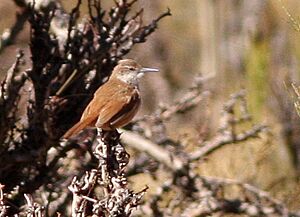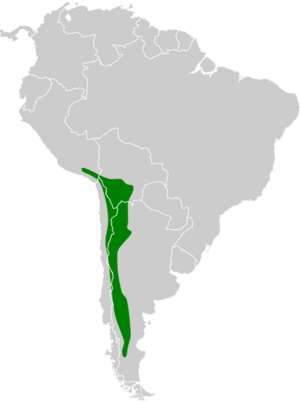Straight-billed earthcreeper facts for kids
Quick facts for kids Straight-billed earthcreeper |
|
|---|---|
 |
|
| Conservation status | |
| Scientific classification | |
| Genus: |
Ochetorhynchus
|
| Species: |
ruficaudus
|
 |
|
| Synonyms | |
|
Upucerthia ruficaudus (Meyen, 1834) |
|
The straight-billed earthcreeper (Ochetorhynchus ruficaudus) is a cool bird that belongs to the ovenbird family. These birds are found in parts of Argentina, Bolivia, Chile, and Peru. They are known for their long, straight beaks, which they use to find food.
Contents
About the Straight-billed Earthcreeper
How Scientists Classify This Bird
Scientists group living things into categories. This helps us understand how they are related. The straight-billed earthcreeper is part of the Ochetorhynchus group.
There are three slightly different types, called subspecies:
- O. r. montanus
- O. r. famatinae
- O. r. ruficaudus
For a while, this bird was placed in a different group called Upucerthia. But in the early 2000s, scientists decided it fit better in its current group.
What Does It Look Like?
The straight-billed earthcreeper is a medium-sized bird. It is about 16 to 19 centimeters (6 to 7.5 inches) long. It weighs between 28 and 41 grams (about 1 to 1.4 ounces). Both male and female birds look alike.
Their faces are a dull brownish color with some lighter spots. They have a thin whitish stripe above their eye. A black stripe goes right through their eye. Their cheeks are whitish.
The top of their head is brown. Their back and rump are a reddish-brown color. The feathers under their tail are a dark reddish color. Their tail feathers are mostly reddish at the base, turning blackish at the tips.
Their throat is whitish. Their chest is also whitish with light brownish streaks. Their belly is a pale reddish-brown. Their eyes are brown. Their beak is black or dark brown, with a lighter base on the lower part. Their legs and feet are black or dark brown.
Young birds have a reddish tint all over. They also have light edges on the feathers of their head and back.
Differences in Subspecies
The O. r. montanus subspecies has a whiter throat and chest. It also has more noticeable streaks on its sides. The O. r. famatinae subspecies has a slightly darker back. It has a whiter chest and darker sides and undertail feathers.
Where Does It Live?
The straight-billed earthcreeper lives in the Andes Mountains in South America. The O. r. montanus subspecies lives in southern Peru and northern Chile. It also lives in Bolivia and northern Argentina.
The O. r. ruficaudus subspecies is found in western Argentina. It also lives in nearby parts of Chile. The O. r. famatinae subspecies lives only in the Sierra de Famatina area of Argentina.
These birds like dry, rocky areas. They prefer places with scattered bushes and tall grasses. You can often find them on rocky hillsides, cliffs, and in ravines. They usually live at high elevations. This is typically between 2,300 and 4,300 meters (about 7,500 to 14,000 feet) above sea level. Sometimes, they can be found as low as 1,300 meters (about 4,300 feet).
Straight-billed Earthcreeper Behavior
How It Moves Around
The straight-billed earthcreeper stays in the same area all year long. It does not migrate to different places.
What It Eats and How It Finds Food
This bird eats small insects and other arthropods. It usually searches for food alone, but sometimes in pairs. It hops among rocks, grasses, and bushes. It picks up its prey from the ground or pulls it out of cracks.
Reproduction and Life Cycle
Scientists believe that straight-billed earthcreepers stay with one partner. They usually breed during the summer in the Southern Hemisphere. This is mostly between November and February.
The bird digs a tunnel in an earthen bank. Sometimes, it uses a crack in a rock instead. It lines its nest with soft materials like grass, hair, and feathers. A female bird usually lays two eggs. We do not know how long the eggs take to hatch. We also do not know how long it takes for the young birds to leave the nest.
What Does It Sound Like?
The song of the straight-billed earthcreeper is loud. It starts with notes that get higher in pitch. Then, the notes slowly go down and fade away. Its call sounds like a sharp "kweep" or "wheet."
Conservation Status
The straight-billed earthcreeper is listed as "Least Concern" by the IUCN. This means that it is not currently in danger of disappearing. It lives in a fairly large area. However, the total number of these birds is not known. Scientists believe their population might be getting smaller.
There are no major threats to this bird right now. It is quite common in the areas where it lives. It is also fairly safe from human activities, except for too much grazing by animals in its habitat.


